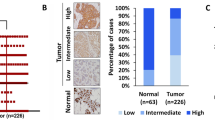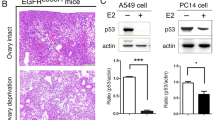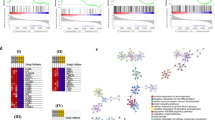Abstract
Both epidemiological and experimental studies indicate that ethanol is a tumor promoter and may promote metastasis of breast cancer. However, the molecular mechanisms underlying ethanol-mediated tumor promotion remain unknown. Overexpression of ErbB proteins in breast cancer patients is generally associated with poor prognosis. The ErbB proteins are a family of receptor kinases that include four closely related members: epidermal growth factor receptor (EGFR/ErbB1), ErbB2/neu, ErbB3, and ErbB4. Particularly, ErbB2 plays a pivotal role in ErbB-mediated activities. Here we demonstrated that amplification of ErbB2 expression sensitized a specific cellular response to ethanol. Human breast cancer cells or mammary epithelial cells with a high expression of ErbB2 exhibited an enhanced response to ethanol-stimulated cell invasion in vitro. Ethanol also stimulated cell proliferation; however, this stimulation was independent of ErbB2 levels. Ethanol triggered divergent intracellular signaling among cells expressing different ErbB2 levels. In the cells overexpressing ErbB2, ethanol was more effective in the activation of c-Jun NH2 terminal protein kinases (JNKs) and p38 mitogen-activated protein kinase (p38 MAPK) as well as the induction of reactive oxygen species (ROS) than the cells with normal ErbB2 expression. Blockage of either JNKs or p38 MAPK activation eliminated ethanol-mediated cell invasion. In contrast, the reduction of hydrogen peroxide concentration by catalase exposure had little effect on ethanol-induced cell invasion. These results indicated that ethanol-induced cell invasion was primarily mediated by JNKs and p38 MAPK, whereas the involvement of ROS formation might be minimal. Our study suggests that overexpression of ErbB2 may augment ethanol-elicited signaling and promote ethanol-stimulated tumor metastasis.
This is a preview of subscription content, access via your institution
Access options
Subscribe to this journal
Receive 50 print issues and online access
$259.00 per year
only $5.18 per issue
Buy this article
- Purchase on Springer Link
- Instant access to full article PDF
Prices may be subject to local taxes which are calculated during checkout






Similar content being viewed by others
References
Alford D, Baeckstrom D, Geyp M, Pitha P and Taylor-Papadimitriou J . (1998). J. Cell. Sci., 111, 521–532.
Bailey SM and Cunningham CC . (1998). Hepatology, 28, 1318–1326.
Bowers G, Reardon D, Hewitt T, Dent P, Mikkelsen RB, Valerie K, Lammering G, Amir C and Schmidt-Ullrich RK . (2001). Oncogene, 20, 1388–1397.
Bowlin SJ, Leske MC, Varma A, Nasca P, Weinstein A and Caplan L . (1997). Int. J. Epidemiol., 26, 915–923.
Carraway III KL, Soltoff SP, Diamonti AJ and Cantley LC . (1995). J. Biol. Chem., 270, 7111–7116.
Castro GD, Delgado de Layno AM, Costantini MH and Castro JA . (2001). Toxicology, 160, 11–18.
Chen YR, Shrivastava A and Tan TH . (2001). Oncogene, 20, 367–374.
Doll R and Peto R . (1981). J. Natl. Cancer Inst., 66, 1192–1309.
Denkert C, Siegert A, Leclere A, Turzynski A and Hauptmann S . (2002). Clin. Exp. Metastasis, 19, 79–85.
Dhar A, Young M and Colburn NH . (2002). Mol. Cell. Biochem., 234–235, 185–193.
Duffy MJ, Maguire TM, Hill A, McDermott E and O'Higgins N . (2000). Breast Cancer Res., 2, 252–257.
Fan S, Meng Q, Gao B, Grossman J, Yadegari M, Goldberg ID and Rosen EM . (2000). Cancer Res., 60, 5635–5639.
Graus-Porta D, Beerli RR, Daly JM and Hynes NE . (1997). EMBO J., 16, 1647–1655.
Hauck CR, Sieg DJ, Hsia D, Loftus JC, Gaarde WA, Monia BP and Schlaepfer DD . (2001). Cancer Res., 61, 7079–7090.
Hiatt R . (1990). Med. Oncol. Tumor Pharmacother., 7, 143–151.
Hoek JB and Pastorino JG . (2002). Alcohol, 27, 63–68.
Hynes NE and Stern DF . (1994). Biochim. Biophys. Acta, 1198, 165–184.
Izevbigie EB, Ekunwe SI, Jordan J and Howard CB . (2002). Exp. Biol. Med. (Maywood), 227, 260–265.
Jurgensmeier JM, Panse J, Schafer R and Bauer G . (1997). Int. J. Cancer, 70, 587–589.
Kelsey J and Horn-Ross PL . (1993). Epidemiol. Rev., 15, 7–16.
Kulisz A, Chen N, Chandel NS, Shao Z and Schumacker PT . (2002). Am. J. Physiol. Lung Cell Mol. Physiol., 282, L1324–L1329.
Kuper H, Ye W, Weiderpass E, Ekbom A, Trichopoulos D, Nyren O and Adami HO . (2000). Br. J. Cancer, 83, 949–951.
Lacroix H, Iglehart JD, Skinner MA and Kraus MH . (1989). Oncogene, 4, 145–151.
Longnecker M . (1994). Cancer Causes Control, 5, 73–82.
Lakka SS, Jasti SL, Kyritsis AP, Yung WK, Ali-Osman F, Nicolson GL and Rao JS . (2000). Clin. Exp. Metastasis, 18, 245–252.
Li Y, Walker DW and King MA . (2001). Free Radic. Biol. Med., 30, 389–392.
Lo YY, Wong JM and Cruz TF . (1996). J. Biol. Chem., 271, 15703–15707.
Luo J and Miller MW . (1997). Alcohol. Clin. Exp. Res., 21, 1186–1194.
Luo J and Miller MW . (1999). J. Neurosci., 19, 10014–10025.
Luo J and Miller MW . (2000). Breast Cancer Res. Treat., 63, 61–69.
Luo J, Sun Y, Lin H, Qian Y, Li Z, Leonard SS, Huang C and Shi X . (2003). J. Biol. Chem., 278, 4542–4551.
Luo J, West JR, Cook RT and Pantazis NJ . (1999). Alcohol. Clin. Exp. Res., 23, 644–656.
Mansat-de Mas V, Bezombes C, Quillet-Mary A, Bettaieb A, D'orgeix AD, Laurent G and Jaffrezou JP . (1999). Mol. Pharmacol., 56, 867–874.
Marshall CJ . (1995). Cell, 80, 179–185.
McCann A, Johnston PA, Dervan PA, Gullick WJ and Carney DN . (1991). Ir. J. Med. Sci., 158, 137–140.
Meng Q, Gao B, Goldberg ID, Rosen EM and Fan S . (2000). Biochem. Biophys. Res. Commun., 273, 448–453.
Mufti SI . (1993). J. Cancer Res. Clin. Oncol., 119, 304–305.
Olayioye MA, Badache A, Daly JM and Hynes NE . (2001). Exp. Cell Res., 267, 81–87.
Olayioye MA, Graus-Porta D, Beerli RR, Rohrer J, Gay B and Hynes NE . (1998). Mol. Cell. Biol., 18, 5042–5051.
Pantel K, Schlimok G, Braun S, Kutter D, Lindemann F, Schaller G, Funke I, Izbicki JR and Riethmuller G . (1993). J. Natl. Cancer Inst., 85, 1419–1424.
Park MJ, Park IC, Hur JH, Kim MS, Lee HC, Woo SH, Lee KH, Rhee CH, Hong SI and Lee SH . (2002). J. Neurosurg., 97, 112–118.
Paterson MC, Dietrich KD, Danyluk J, Paterson AH, Lees AW, Jamil N, Hanson J, Jenkins H, Krause BE, McBlain WA, Slamon DJ and Fourney RM . (1991). Cancer Res., 51, 556–567.
Plant ML . (1992). Int. J. Addict., 27, 107–128.
Plowman GD, Green JM, Culouscou JM, Carlton GW, Rothwell VM and Buckley S . (1993). Nature, 366, 473–475.
Qiu MS and Green SH . (1991). Neuron, 7, 937–946.
Reunanen N, Li SP, Ahonen M, Foschi M, Han J and Kahari VM . (2002). J. Biol. Chem., 277, 32360–32368.
Reinke LA . (2002). Free Radic. Biol. Med., 32, 953–957.
Rosenberg L, Metzger LS and Palmer JR . (1993). Epidemiol. Rev., 15, 133–144.
Sano M, Fukuda K, Sato T, Kawaguchi H, Suematsu M, Matsuda S, Koyasu S, Matsui H, Yamauchi-Takihara K, Harada M, Saito Y and Ogawa S . (2001). Circ. Res., 89, 661–669.
Schmidt-Ullrich RK, Contessa JN, Dent P, Mikkelsen RB, Valerie K, Reardon DB, Bowers G and Lin PS . (1999). Radiat. Oncol. Investig., 7, 321–330.
Shi XL and Dalal NS . (1991). Arch. Biochem. Biophys., 289, 355–361.
Shin EY, Kim SY and Kim EG . (2001). Exp. Mol. Med., 33, 276–283.
Shin M, Yan C and Boyd D . (2002). Biochim. Biophys. Acta, 1589, 311–316.
Simon C, Simon M, Vucelic G, Hicks MJ, Plinkert PK, Koitschev A and Zenner HP . (2001). Exp. Cell Res., 271, 344–355.
Singletary K . (1997). Alcohol. Clin. Exp. Res., 21, 334–339.
Singletary KW, Frey RS and Yan W . (2001). Cancer Lett., 165, 131–137.
Singletary KW and Gapstur SM . (2001). JAMA, 286, 2143–2151.
Slamon DJ, Clark GM, Wong SG, Levin WJ, Ullrich A and McGuire WL . (1987). Science, 235, 177–182.
Sliwkowski MX, Schaefer G, Akita RW, Lofgren JA, Fitzpatrick VD, Nuijens A, Fendly BM, Cerione RA, Vandlen RL and Carraway III KL . 1994. J. Biol. Chem., 269, 14661–14665.
Smith-Warner SA, Spiegelman D, Yau SS, Vandenbrandt PA, Folsom AR, Goldbohm RA, Graham S, Holmberg L, Howe GR, Marshall JR, Miller AB, Potter JD, Speizer FE, Willett WC, Wolk A and Hunter DJ . (1998). JAMA, 279, 535–540.
Spencer KS, Graus-Porta D, Leng J, Hynes NE and Klemke RL . (2000). J. Cell. Biol., 148, 385–397.
Sun Y, Lin H, Zhu Y, Ma C, Ye J and Luo J . (2002). J. Cell. Physiol., 192, 225–233.
Swanson CA, Coates RJ, Malone KE, Gammon MD, Schoenberg JB, Brogan DJ, McAdams M, Potischman N, Hoover RN and Brinton LA . (1997). Epidemiology, 8, 231–237.
Talvensaari-Mattila A, Paakko P, Hoyhtya M, Blanco-Sequeiros G and Turpeenniemi-Hujanen T . (1998). Cancer, 83, 1153–1162.
Tan M, Yao J and Yu D . (1997). Cancer Res., 57, 1199–1205.
Tauchi K, Hori S, Itoh H, Osamura RY, Tokuda Y and Tajima T . (1989). Virchows. Arch. A Pathol. Anat. Histopathol., 416, 65–73.
Tombes RM, Auer KL, Mikkelsen R, Valerie K, Wymann MP, Marshall CJ, McMahon M and Dent P . (1998). Biochem. J., 330 (Part 3), 1451–1460.
Tzahar E, Waterman H, Chen X, Levkowitz G, Karunagaran D, Lavi S, Ratzkin BJ and Yarden Y . (1996). Mol. Cell. Biol., 16, 5276–5287.
Vaeth PAC and Schlessinger WA . (1998). Alcohol. Clin. Exp. Res., 22, 928–934.
Verma M and Davidson EA . (1999). Cancer Biochem. Biophys., 17, 1–11.
Watabiki T, Okii Y, Tokiyasu T, Yoshimura S, Yoshida M, Akane A, Shikata N and Tsubura A . (2000). Alcohol. Clin. Exp. Res., 24 (4 Suppl), 117S–122S.
Weiss HA, Brinton LA, Brogan D, Coates RJ, Gammon MD, Malone KE, Schoenberg JB and Swanson CA . (1996). Br. J. Cancer, 73, 1298–1305.
Wright RM, McManaman JL and Repine JE . (1999). Free Radic. Biol. Med., 26, 348–354.
Ye J, Xu RH, Taylor-Papadimitriou J and Pitha PM . (1996). Mol. Cell. Biol., 16, 6178–6189.
Zhu Y, Lin H, Li Z, Wang M and Luo J . (2001a). Breast Cancer Res. Treat., 69, 29–38.
Zhu Y, Lin H, Wang M, Li Z, Wiggins RC and Luo J . (2001b). Int. J. Oncol., 18, 1299–1305.
Acknowledgements
We thank Kimberly A Bower for her reading of this manuscript. This research was supported by grants from the National Institutes of Health (AA12968 and CA90385) and a grant from Alcohol Beverage Medical Research Foundation.
Author information
Authors and Affiliations
Corresponding author
Rights and permissions
About this article
Cite this article
Ma, C., Lin, H., Leonard, S. et al. Overexpression of ErbB2 enhances ethanol-stimulated intracellular signaling and invasion of human mammary epithelial and breast cancer cells in vitro. Oncogene 22, 5281–5290 (2003). https://doi.org/10.1038/sj.onc.1206675
Received:
Revised:
Accepted:
Published:
Issue Date:
DOI: https://doi.org/10.1038/sj.onc.1206675
Keywords
This article is cited by
-
Alcohol and breast cancer
Pharmacological Reports (2023)
-
ErbB2 and p38γ MAPK mediate alcohol-induced increase in breast cancer stem cells and metastasis
Molecular Cancer (2016)
-
Activation of the NF-κB pathway as a mechanism of alcohol enhanced progression and metastasis of human hepatocellular carcinoma
Molecular Cancer (2015)
-
Butein suppresses breast cancer growth by reducing a production of intracellular reactive oxygen species
Journal of Experimental & Clinical Cancer Research (2014)
-
MT1-MMP in breast cancer: induction of VEGF-C correlates with metastasis and poor prognosis
Cancer Cell International (2013)



